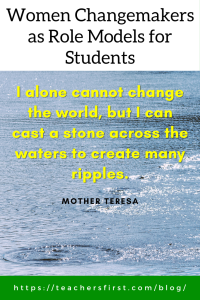“I alone cannot change the world, but I can cast a stone across the waters to create many ripples.”
Mother Teresa
History books are lined with pages about changemakers who dared to challenge norms and expectations and rewrite rules. Unfortunately, most changemakers we read about in history books are men, so it is important to be deliberate in sharing women as changemakers with our students. Also important is to help students recognize their potential as a changemaker.
As you begin a new school year, one option to help students recognize their potential as a changemaker is to highlight changemakers (especially women) throughout the school year and also recognize the qualities and actions of students as changemakers.
Let’s look at how this might take place; of course, you will want to adjust these activities to fit your class’s grade level and subject:
- Begin by defining a changemaker. Interestingly, this definition isn’t found in Webster’s Dictionary online or on Dictionary.com; however, the Urban Dictionary provides a short definition along with the origination of this term. Ask students to create their definition of a changemaker and post that definition prominently in your classroom and on your class website.
- Share and discuss different categories of changemakers. This example provides six types of changemakers – builders, networkers, nurturers, resisters, communicators, and investigators. As students learn about changemakers, use Google Jamboard (reviewed here) to build a database of the different types of changemakers and women that fit into each criterion, such as the one found here.
- Explore the characteristics found in changemakers. Examples might include vision, passion, perseverance, empathy, resourcefulness, and action-oriented.
- Discuss examples of women changemakers and how they fit into each category and display characteristics found in changemakers. You and your students may find that changemakers fit into more than one category and display many of the characteristics described; when that happens, determine the most predominant features to share. For example:
- Mother Teresa: Nurturer/Communicator
- Visionary approach to addressing the needs of the poor
- Passion through her life’s dedication to helping the poor
- Collaborative approach to helping others by reaching out to find volunteers, resources, and help for those in need
- Maria Montessori: Nurturer
- Visionary approach to education
- Perseverance when faced with opposition from others in the education community
- Empathy and compassion in her approach to educating each child as an individual
- Mother Teresa: Nurturer/Communicator
- Once students understand the definition and characteristics of changemakers, it is time to encourage students to recognize those characteristics within themselves. Some ideas to encourage students to identify and share these characteristics throughout the year are:
- Create a bulletin board about changemakers that includes areas for each of the different kinds of changemakers. Ask students to add to the bulletin board when they see examples in the school, such as a student who creates a positive change in homework, class policies, or changes in their community.
- Use Flip (reviewed here) to share student changemaker stories. As new videos are created, share them with the class and celebrate student accomplishments together.
- Find more ideas on encouraging students to recognize themselves as changemakers in this article by Michelle Blanchet. Ms. Blanchet shares several suggestions, including writing challenge questions, investigating questions, and synthesizing ideas.
As Amanda Gates said, “Remember that no one is born a changemaker. It’s something you become when you see a problem, then dare to become part of the solution.”
How do you encourage students to recognize the changemaker in themselves? We would love to hear your ideas as we learn together.


